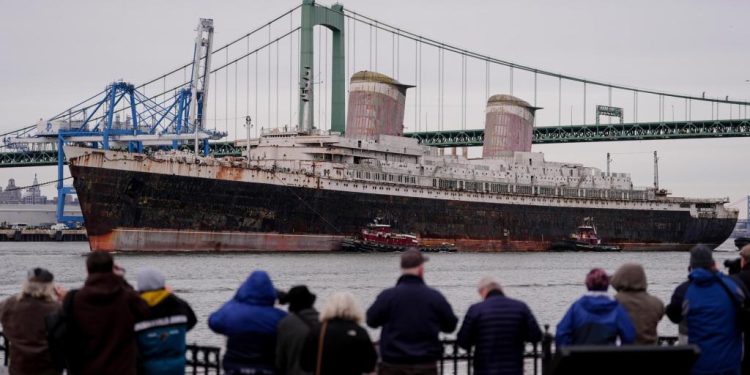By David Fischer
A historic liner will become the largest artificial reef in the world once it has reached its last place to rest off the Côte du Gulf de la Florida. Competing diving companies compete so that the massive ship is scuttled closer to them, while a group continues to prevent the ship from being sunk.
The United States, a ship of almost 1,000 feet (305 meters) which broke the transatlantic speed record during its inaugural trip in 1952, passed by a park at one month at the port of Mobile in Alabama.
Workers will empty and clean the 120 fuel tanks, as well as chemicals, wiring, plastic and glass.
“There are many bad guys on the ships that were built in the 1950s,” said Okaloosa County County Director Alex Fogg. “Basically, when it is ready to be deployed, it will be a steel and aluminum structure.”
The United States SS should reach more than 500 artificial reefs from Okaloosa County, which includes a dozen wrecks of smaller ships. Officials hope to attract tourists and generate millions of dollars a year for diving stores, fishing boats and charter hotels, as well as to provide a habitat for critical fish and other maritime lives.
“The objective here is to be the diving capital of the state of Florida,” said Fogg. “We even try to go beyond Florida Keys.”
Fogg said they expected the United States to flow at the end of the year in one of the three authorized places, all more than 20 naval miles (37 kilometers) in Destiny, Florida. The three locations are of the same depth, about 180 feet (55 meters) of water on the sand, but the ship is so large that the upper bridges will be about 60 feet (18 meters) from the surface.
“It is really in the beginner diver profile, and these deeper depths will certainly be attractive for these technical and advanced divers,” said Fogg.
Bay County officials agreed to offer $ 3 million to Okaloosa County to drive the United States closer to Panama City Beach.
Visit the president and chief executive officer of Panama City Beach, Dan Rowe. Bay County has a long history of technology development used in underwater exploration and the US Navy’s Dive School is located in the Panama City naval support activity.
“Diving is part of our DNA,” said Rowe.
Escambia county officials offer only $ 1 million to drive the ship closer to Pensacola, but visit the president and chief executive officer of Pensacola, Darien Schaefer, said that the Western location was only 12 sea miles (22 kilometers) from USS Oriskany, another popular diving site in 2006. Visit the two wrecks in one day.
“We just think it would be a legendary diving site to have these two wrecks nearby,” said Schaefer.
The United States arrived in Alabama in early March following a 12-day towing of the Delaware river in Philadelphia, where it spent almost three decades. The county of Okaloosa was able to appropriate the ship after an old rent dispute was resolved in October between the Conservancy which oversees the ship and its owner.
Various groups have attempted to restore SS in the United States over the years, but all plans have finally been abandoned due to the high cost. Recently, the increased attention from the media has generated more calls to preserve the ship, and a group called the New York Coalition even filed a complaint before the Federal Pensacola Court asking a judge to arrest such a significant ship.
But preventing SS in the United States from becoming a reef only sends it to Scracy’s courtyard, said Fogg. In addition, the county’s $ 10.1 million dollar plan to buy, move, clean and sink the ship includes $ 1 million to an earth museum to promote the history of the ship.
“Once the ship is deployed as an artificial reef, there will be more people who will visit it during the first month of it underwater than to have visited it in the past 30 years,” said Fogg.
The United States SS, more than 100 feet (30 meters) longer than the RMS Titanic, were once considered as an American engineering lighthouse, dubbing as a military ship that could transport thousands of troops. His inaugural journey broke the transatlantic speed record in both directions when he reached an average speed of 36 knots, or just over 41 MPH (66 km / h), the Associated Press reported on board the ship.
The ship crossed the Atlantic Ocean in three days, 10 hours and 40 minutes, beating the time of the 10 -hour Queen RMS. To date, the SS United States has the transatlantic speed record for an ocean liner.
Originally published:
California Daily Newspapers


